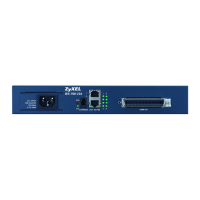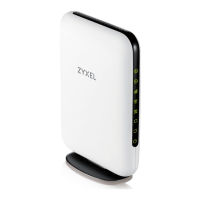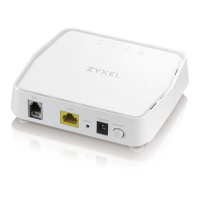Chapter 17 Reputation Filter
USG FLEX H Series User’s Guide
285
17.4.1 URL Threat Filter Allow List Screen
Use this screen to create allow list entries. The Zyxel Device will allow incoming packets from the listed
IPv4 addresses and URLs.
Click Security Service > Reputation Filter > URL Threat Filter > Allow List to display the configuration screen
as shown next.
Denied Access
Message
Enter a message to be displayed when the URL Threat filter blocks access to a web page.
Use up to 127 characters (0-9a-zA-Z;/?:@&=+$\.-_!~*'()%,”). For example, “Access to this
web page is not allowed. Please contact the network administrator”.
It is also possible to leave this field blank if you have a URL specified in the Redirect URL field.
In this case if the URL Threat filter blocks access to a web page, the Zyxel Device just opens
the web page you specified without showing a denied access message.
Redirect URL Enter the URL of the web page to which you want to send users when their web access is
blocked by the URL Threat filter. The web page you specify here opens in a new frame
below the denied access message.
Use “http://” or “https://” followed by up to 262 characters (0-9a-zA-Z;/?:@&=+$\.-_!~*'()%).
For example, http://192.168.1.17/blocked access.
Security Threat
Categories
Select the categories of web pages that may pose a security threat to network devices
behind the Zyxel Device.
Anonymizers Sites and proxies that act as an intermediary for surfing to other Web sites in an anonymous
fashion, whether to circumvent Web filtering or for other reasons.
Browser Exploits Sites that contain browser exploits. A browser exploit is any content that forces a web
browser to perform operations that you do not explicitly intend.
Malicious
Downloads
Sites that have been identified as containing malicious downloads or malware harmful to a
user's computer.
Malicious Sites Sites that install unwanted software on a user's computer with the intent to enable third-
party monitoring or make system changes without the user's consent.
Phishing Sites that are used for deceptive or fraudulent purposes, such as stealing financial or other
user account information. These sites are most often designed to appear as legitimate sites
in order to mislead users into entering their credentials.
Spam URLs Sites that have been promoted through spam techniques.
Spyware Adware
Keyloggers
Sites that contain spyware, adware or keyloggers.
• Spyware is a program installed on your computer, usually without your explicit
knowledge, that captures and transmits personal information or Internet browsing habits
and details to companies. Companies use this information to analyze browsing habits,
to gather marketing data, and to sell your information to others.
• Key logger programs try to capture and steal your passwords and watch and record
everything you do on your computer.
• Adware programs typically display blinking advertisements or pop-up windows when
you perform a certain action. Adware programs are often installed in exchange for
another service, such as the right to use a program without paying for it.
Test URL Threat
Category
URL to test Enter a URL using http://domain or https://domain and click the Query button to check if
the domain belongs to a URL threat category.
Apply Click Apply to save your changes.
Reset Click Reset to return the screen to its last-saved settings.
Table 143 Security Service > Reputation Filter > URL Threat Filter
LABEL DESCRIPTION

